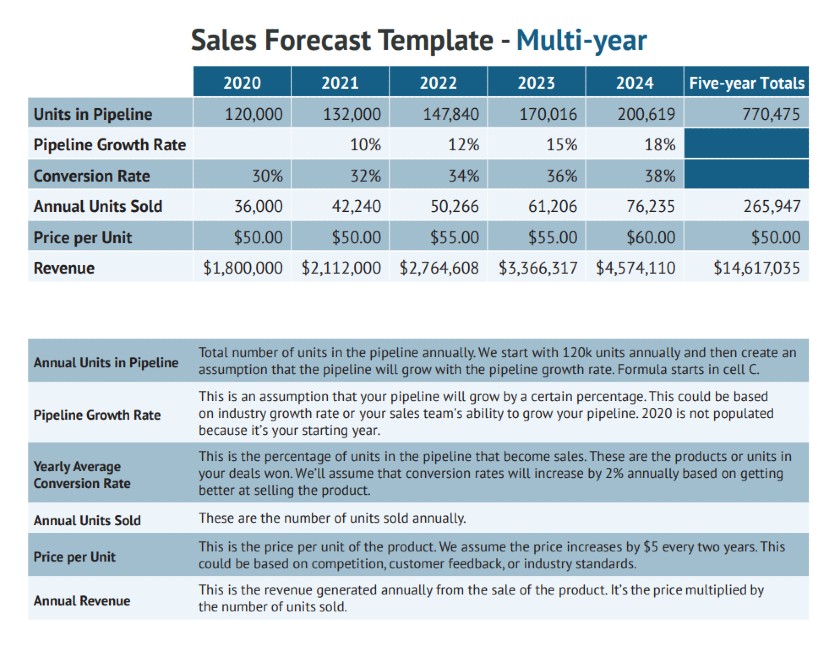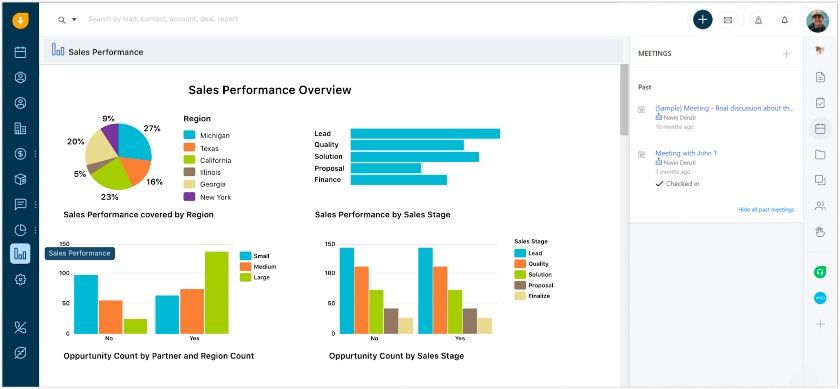Setting sales goals provides a roadmap for establishing measurable, achievable objectives needed to meet your revenue and growth goals. It entails determining your break-even point, identifying your desired profitability, and setting sales objectives. You should also incorporate target revenue into your sales goals and communicate them to your team. Learn how to set sales goals for your business without overwhelming—or underwhelming—your sales reps.
Download this free template with simple sales goals examples, and use it as you follow the five easy steps below to set your organizational sales goals:
Thank you for downloading!
💡 Quick Tip:
Use a CRM software to help you set your sales goals and measure its effectiveness accurately.
Consider providers like Pipedrive which has robust sales tools that can help you evaluate your month-to-month business performance to see if your sales goals are working for you.
Setting sales goals entails careful planning and consideration. Below, we share the five-step process for goal setting for salespeople:
1. Determine Your Break-even Point
Whether objectives are based on revenue, customer retention, or total new deals closed, setting sales goals starts by understanding how much money your business needs to stay afloat and be profitable. This is done by identifying your organization’s break-even point, which is the total amount of revenue your business needs to net $0 after meeting all of its financial obligations.
Using historical data and projections, calculate how much you expect to spend on all business expenses, such as salaries, marketing costs, office space, technology, legal fees, insurance, taxes, and accounting. The total should be for a one-year outlook, but you can also do longer-term break-evens like three or five years. If you’re looking for more than a year, remember to factor in aspects like expected inflation.
2. Establish Desired Profitability
Once you’ve determined how much revenue is needed to keep your business operational, set profitability goals. This refers to the amount of sales revenue above the break-even point you would like to make. It could be a set percentage, such as aiming to make a 20% profit, or a set amount, like wanting to net $100,000.
While setting desired profitability, consider recurring customers, resources, and your ability to bring in new customers. Also, evaluate the expected market growth of your industry. For instance, industries like cybersecurity software are fast-growing compared to others, such as office suppliers. Therefore, your goals can be bolder when it comes to desired profitability in high-growth markets since growth potential is higher.
Pro tip: Set your sales goals using the SMART goals method as a guide. It helps to come up with goals for sales that are specific, measurable, achievable, relevant, and time-bound. This way, you ensure your organization’s smart sales goals are not open-ended, but are designed to yield results you can evaluate to determine your success.
3. Incorporate Revenue Into Your Sales Goals
By establishing the desired profitability above your break-even point, calculate how much revenue you want to bring in during the period (typically a year). That amount is your total sales revenue goal, but that does not end the process of setting sales goals. Your revenue goal also needs to be incorporated into sales goals.
The simplest way to translate your company’s revenue goal into your sales goals is to use the exact number. For example, if your revenue goal is $200,000, simply set your total sales goal as $200,000.
You may determine it’s better to set sales goals based on other measures, such as deals closed, leads generated, or activity deliverables like calls placed, emails sent, and appointments scheduled. Sometimes it’s more advantageous to use sales activities for goals because a sales rep has full control over completing specified activities, but not necessarily the outcomes, which are also contingent on the prospect making a purchase decision.
One way to set performance or activity goals for your sales team is by using sales forecast estimates. To learn how to accurately generate sales forecasts, check out our free sales forecast templates. These templates show how to project sales for various situations based on your business type and needs.

After setting a revenue goal, segment the total sales revenue goal into incremental steps. Goal segmentation allows you to break down your requirements into smaller goals to make your sales goals feel more achievable and make it easier to measure progress.
Here are some ways you can divide a revenue goal into more specific sales goals:
- Segment by time frame: Break down the annual revenue goal by quarter, month, or week. Make sure to consider holidays and other paid time off (PTO) since they affect how many selling days your business will have. From there, calculate how much revenue your team needs to bring in on average each day to meet your annual revenue goal.
- Segment by revenue source: Separate your desired goal based on new business and current customers. Businesses like insurance agencies, financial advisers, and software as a service (SaaS) providers tend to have higher residual income, also known as revenue from recurring customers. However, others, such as real estate agencies, depend more on acquiring new customers to meet revenue goals.
- Segment by teams: Divide the annual goal into subsection goals, such as product category, geographic area, or departmental teams. Generally, this won’t be an even division as it should be segmented based on the revenue generation potential of each. In other words, some are inherently able to produce more revenue than others.
- Segment by individual sales reps: Break down the sales goal by how much each rep needs to bring in or accomplish. To set sales quotas for your team, take into account their experience, resources, and current business relationships.
- We’ve created a sales revenue quota calculator to help you calculate each of your team members’ sales quota:
- Segment by product or service: Divide your annual sales goal by how much you want to bring in per product line or service offering.
The more sales goal segmentation you have, the more specific your strategies can be. You also have the option to segment goals based on just one of these methods or using multiple methods listed above. The larger or more complex your business or offerings are, the more important it may be to segment goals in multiple ways.
For instance, a simple, single-method option would be setting a 50/50 sales revenue goal between two different products. On the other hand, a multimethod segment could include breaking down your revenue into monthly goals for each sales rep. It will also entail stating that the sales revenue produced by each agent should be 70% new business and 30% existing customers.
4. Set Sales Objectives
Operational sales objectives are an essential part of setting sales goals. They ensure your sales team has a plan to achieve the sales goals set for them as individuals, as a team, and for the organization as a whole.
Sales objectives break down goals into the weekly, or daily activities agents need to complete to meet sales goals, such as the number of cold calls placed, emails sent, appointments set up, or leads generated.
When setting objectives, you need information about sales funnel conversion rates. This refers to the rate of leads that go through each stage of the funnel.
For example, if for every 100 new eligible leads you generate (and add to the sales funnel), 15 become paying customers after getting through the sales process, your total closing rate is 15%. Based on this, as well as the average revenue generated per sale and the activities needed to generate 100 leads, you can set specific objectives for your sales team.
Below is a sample breakdown of turning conversion rates into a set sales objective. First, here are example conversion rates:
- Your annual sales goal is to close 20 deals
- Your conversion rate for getting a lead to agree to a product demo through cold calling is 4%
- Your conversion rate of having the lead want to receive a quote after a product demonstration is 50%
- Your conversion rate of leads who received a business proposal and who then sign on and become paying customers is 30%
Based on these conversion rates, your team must place 3,333 total cold calls to different leads during the year. 3,333 calls will produce 133 product demonstrations, which will, in turn, yield 66 proposals, of which about 20 will be won. 3,333 cold calls can be broken down into 278 per month and about 69 per week. Divide 69 by the number of agents engaging in cold calling to determine how many cold calls an individual rep needs to make each week, or even each day.
Keep in mind that different sales goals will result in varying types of sales objectives. For instance, if your annual sales goal is 100 deals closed with no indication of total revenue, your sales team is more likely to focus on high-volume prospectings, such as attempting to generate as many leads as possible through cold calling campaigns or mass emailing.
Alternatively, to achieve a revenue goal of $500,000, your team may focus less on volume and more on deal value. This would entail prospecting activities to get well-researched leads they know would be highly profitable contracts into your sales pipeline. Measuring progress is then based on monitoring the total potential deal value vs. the number of opportunities.
Did you know?
It takes about 18 calls to reach a potential customer, and nearly six out of 10 prospects ask about pricing during the first conversation. For more statistics that can inform goal setting and sales management, check out our interesting article with the top sales statistics you need to know.
5. Communicate Sales Goals
Once the process of setting sales goals is complete, and you know how much activity needs to occur for your reps to hit them, communicate the goals to your team. To get everyone on the same page, first, have a team meeting to outline your business’ aggregate sales goals. Then, discuss with each rep individually how much and what types of activity are expected to hit their goals in the sales plan.
When communicating sales goals that have different measurables, such as saying you want your sales team to close a certain number of deals and bring in X amount of revenue, make sure to prioritize which goal is more important. For example, your revenue goal is likely more crucial, so emphasize to your sales team that as long as revenue goals are accomplished, it’s not as important how many deals are closed.
Managing sales goals is an ongoing process that should happen weekly for activity-based goals and monthly for performance goals like revenue generated or deals closed. Typically, it’s going to be a sales manager who is responsible for tracking their sales rep’s activity and production.
If a sales rep falls behind their sales goals, find out the cause and make operational adjustments. This might include supplying more leads or finding ways to automate specific tasks such as data entry. On the other hand, if their lack of performance is skill-related, you can provide them with one-on-one coaching or enroll them in an effective sales training program.
If you need to adjust your sales goals and require more activity from your sales team, do so incrementally. For instance, if your adjusted sales goal requires 40 additional cold calls to be placed each week, slowly implement the new objectives by adding five one week, 10 the next, 15 after that, and so on, until they are doing 40 additional calls per week. This gives agents time to adjust their workday patterns and prevents them from feeling overwhelmed.
Tools for Managing Sales Goals
Once you’ve set sales goals and communicated them to your team, you need processes in place to manage progress. This includes everything from motivating your team to monitoring progress and providing sales coaching when it’s needed. This is essential because it’s not uncommon for a business to set a sales goal and then fail to enforce the goal or the activities needed to achieve it.
The most common method to manage and monitor your sales goals is using customer relationship management (CRM) software. Most CRMs have measuring tools to help you monitor your team’s performance, including tracking their activities and the number of sales they bring into the business.
Other providers, like Freshsales, have the functionality to break down sales performance into various areas and metrics. It can inform businesses how their sales performed per region or sales stage—helping them identify their highest and lowest sales drivers.

Freshsales breaks down various areas of sales performance, which businesses can compare with their sales goals. (Source: Freshsales)
Incentives, such as bonuses, gift cards, prepaid cards, and other rewards, are an effective way to keep your sales teams motivated to hit and exceed their sales objectives and goals. Providers, such as WooBoard, let you manage reward incentives by giving out dollar amounts to employees for achievements that can be spent on gift cards.

WooBoard allows users to reward their agents based on their business performance. (Source: WooBoard)
Another way to motivate your team to work toward your set sales goals is to use sales gamification software. It helps turn sales performance, including activities related to sales objectives, into a friendly competition to motivate and incentivize meeting sales goals.
Providers like LevelEleven help you manage your sales goals by monitoring your team’s activity, goal progress, and providing coaching when needed. The LevelEleven dashboard, for example, enables a sales manager to create a note of encouragement to congratulate or motivate a rep or offer advice to assist them.

LevelEleven’s leaderboard shows your agents’ standing in real time. (Source: LevelEleven)
Benefits of Setting Sales Goals
Setting sales goals that are realistic but still challenge your sales team is essential for success in any sales management role. It requires you to understand your business’ finances, growth goals, and sales operations. When done properly, goal setting establishes objective expectations for your sales teams that can be easily measured.
Here are some of the top benefits of setting and managing sales goals:
- Syncs everyone’s expectations: Setting and communicating sales goals ensures everyone knows what’s expected of them in terms of performance and its contribution to overall team and company goals.
- Provides a roadmap of activities: Sales objectives let each team and team member know exactly what they need to do to hit their goals.
- Allows for accountability: Setting sales goals enables you to hold sales reps and managers accountable in the event objectives and goals are not met.
- Offers a threshold for praise: When your team or an individual exceeds a sales goal or objectives, it becomes a basis for credit, recognition, and rewards.
Bottom Line
Setting sales goals is crucial for business growth as it provides a detailed game plan and accountability for sales managers and reps. Ensure the goals are realistic and communicated properly, so employees feel it’s an exciting challenge instead of an overwhelming burden. Continuous management of goals, including recognition, incentives, and adjustments, is also essential for achieving them.
Download the free template above to set your organization’s sales goals and determine if targets aligned with your business goals are realistically attainable.